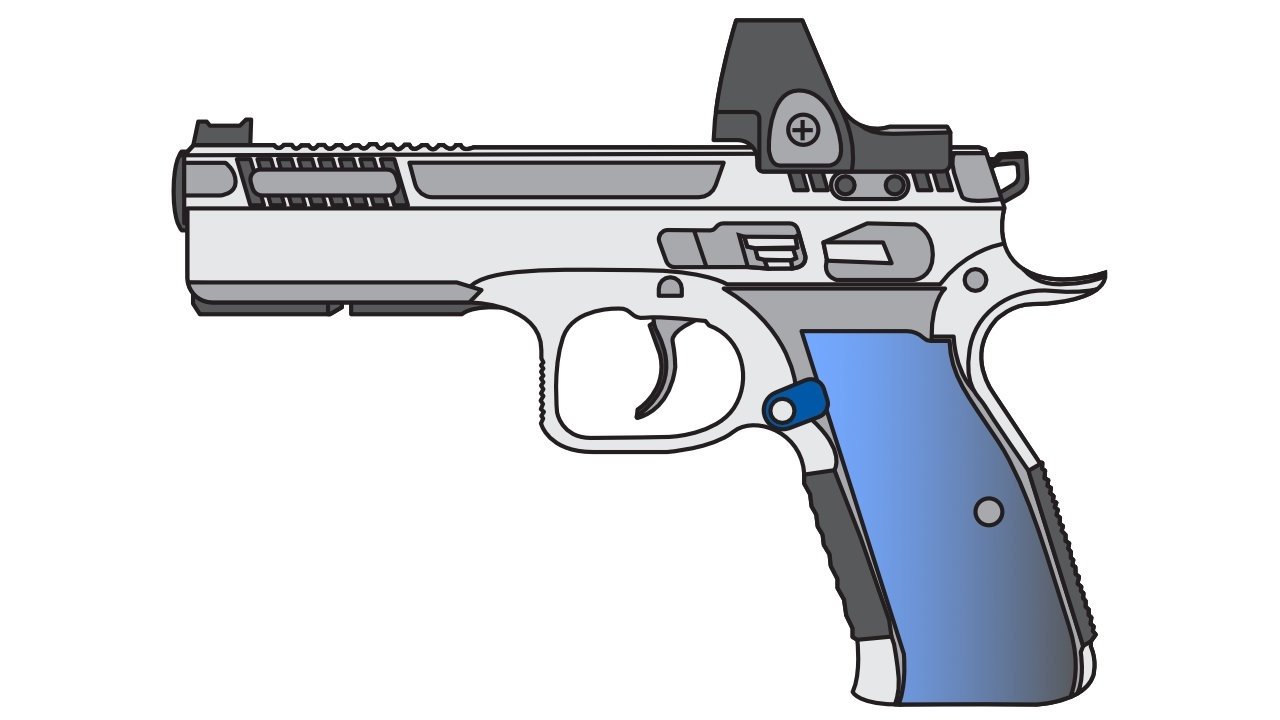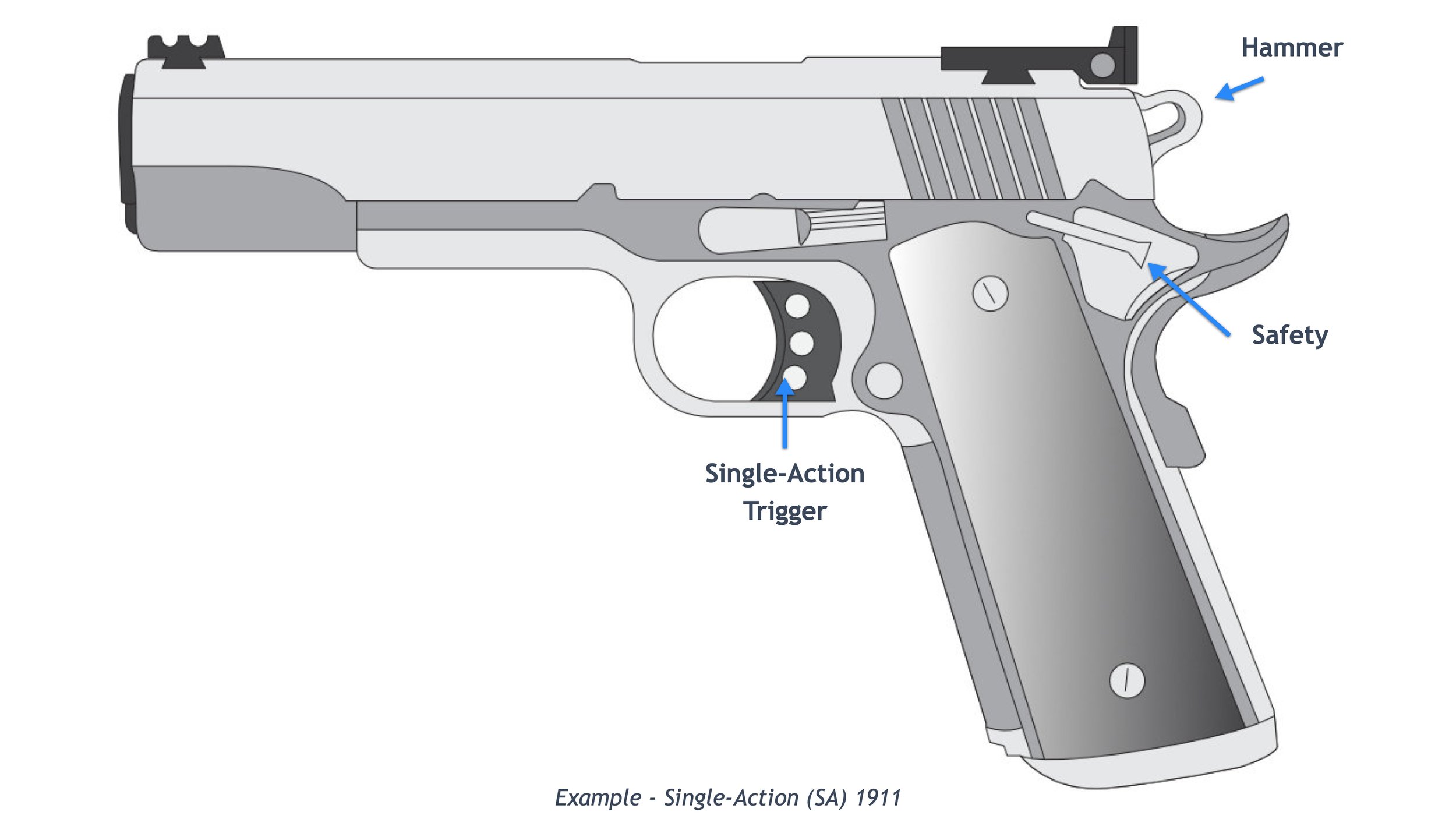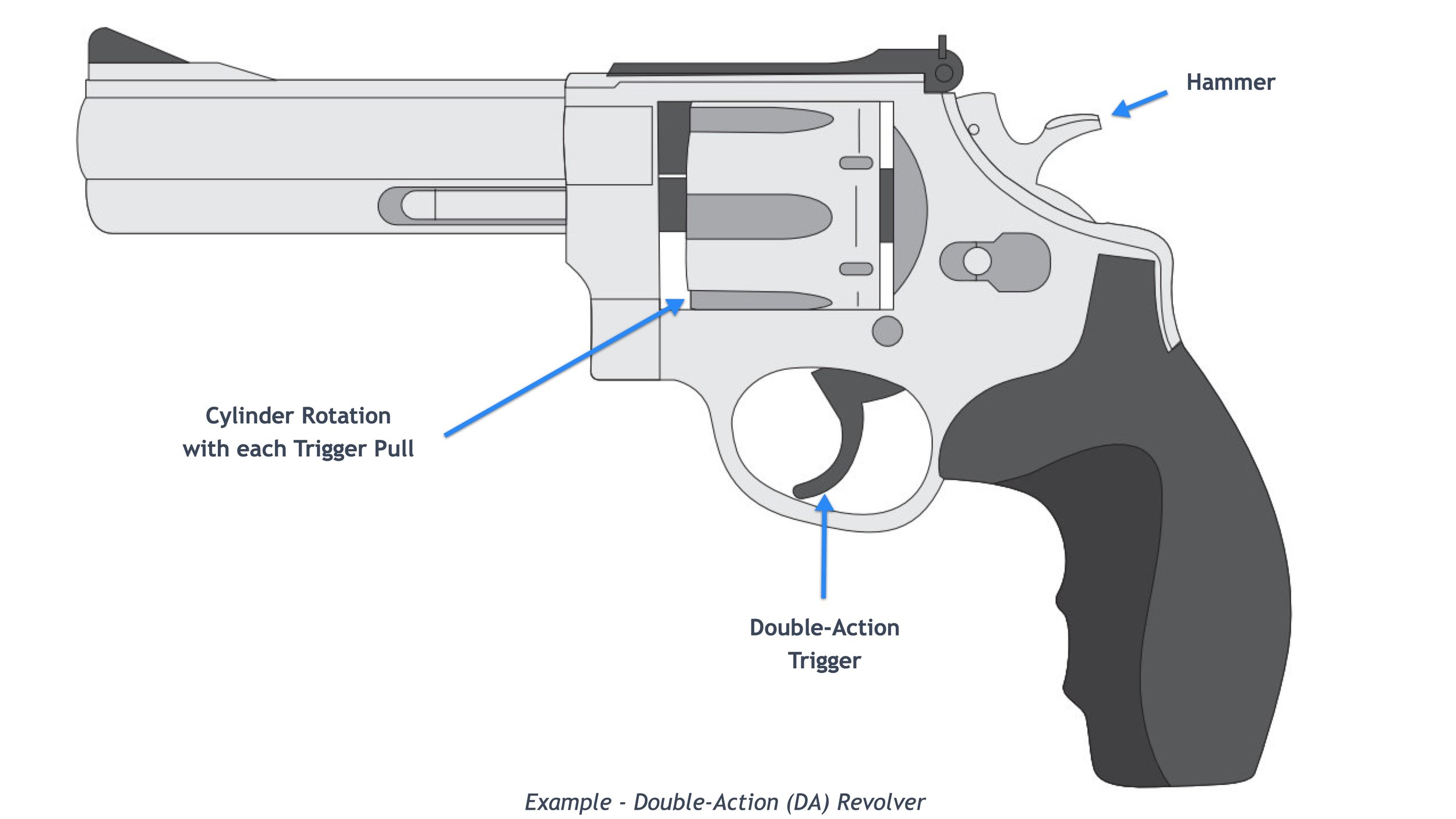What are the different Trigger Action types, and how do they work?
TRIGGER ACTION TYPES
Trigger Action refer to how a firearm operates with each trigger press. There are two common types of trigger actions: single-action and double-action. Some firearms incorporate both.
The trigger mechanism or action releases the striker or hammer, so it causes the primer on a cartridge to be struck and fire a shot. Depending on the action type, other operations (to prepare the firearm to fire) may be tied to each trigger press.
A striker-fired gun uses a striker rod or firing pin driven by a spring that hits the bullet primer. Striker-fired handguns are very popular and straightforward to operate. These designs incorporate the safety mechanism into the trigger, and all the firing mechanisms are internal to the firearm.
A hammer-fired design uses a hinged lever that strikes a firing pin that hits the bullet primer. Hammer-fired designs are used in 1911 designs, revolvers, and many competition pistols.
Trigger Stages
While trigger actions differ by design, modern firearms share a similar sequence when you pull the trigger. Understanding these stages can help you improve competitive consistency and appreciate the differences each type offers.
Stage 1: Take-Up / Pre-Travel / Slack
The initial movement of the trigger before you feel resistance is called the take-up, pre-travel, or slack. In single-action and striker systems, this stage is typically short and smooth, requiring minimal effort to reach the point of resistance. In contrast, double-action pulls have a longer and heavier take-up because the trigger is also cocking the hammer or striker during this movement.
Stage 2: The Wall / Resistance
The wall is the point of noticeable resistance that comes after the pre-travel. A crisp, well-defined wall gives the shooter feedback, allowing a brief pause to refine aim before pressing through the break. Conversely, a soft or indistinct wall reduces feedback and requires a different technique where the trigger is pressed straight through in one controlled motion. The goal is to avoid hesitation or searching for a wall that isn’t there, which can lead to sight disturbance and inconsistent breaks.
Stage 3: The Break
The break is the instant the hammer or striker is released, firing the shot. This moment is often described as either “crisp,” with a sharp, clean break, or “rolling,” where the release feels smoother and more gradual. Many competition shooters prefer a clean, predictable break because it allows for precise timing and minimal disturbance to their sight picture at the exact moment the shot is fired.
Stage 4: Over Travel
Over Travel refers to the movement of the trigger after the break, and the shot has been fired. While some overtravel is necessary for proper function, too much movement can slow your reset time and affect competitive performance. Some triggers feature adjustable stops that limit overtravel, helping competitors maintain faster, more consistent resets and follow-up shots.
Stage 5: The Reset
The reset is the forward movement of the trigger needed to re-engage the firing mechanism and prepare the pistol for the next shot. A short, tactile reset provides clear feedback and enables faster follow-up shots, making it a favorite feature among competitive shooters.
Single-Action (SA)
The single-action trigger performs one action for each trigger pull. That signal action releases the striker or hammer, so it hits the bullet primer, and the gun fires. Because single-action is just a simple release operation, it takes another action (recoiling of the slide on the pistol) to cock the hammer/striker for subsequent shots. The single-action is usually a lighter trigger pull because it is only performing one action to fire the pistol. Many Single-Action pistols incorporate external manual safeties to make the firearm safe when the hammer is in the cocked position.
Double-Action (DA)/Double-Action Only (DAO)
The double-action trigger performs two actions for each trigger pull. Each trigger press will cock the hammer or firing pin, then release them. Revolvers provide a good example of a double-action-only design because you can see both actions at work as you pull the trigger. When you start to pull the trigger, the cylinder will rotate by moving the cartridge into place. Then the hammer is pulled back in preparation to fire. As you continue through the press, the cylinder stops, and the hammer is released. A double-action trigger will have a heavier trigger pull as it is performing two operations in order to fire the pistol. See the Double-Action Revolver example below.
A double-action striker-fired pistol system can feel more like a single-action trigger but as you pull the trigger it does perform an internal cocking and release of the internal striker. See the Double-Action semi-automatic pistol below.
Double-Action/Single-Action (DA/SA)
Double-action and single-action pistols start in double-action for the first trigger pull, then perform in single-action thereafter. This means the first trigger press will cock the hammer or striker and fire a shot. The recoil from the first shot will cause the pistol to cycle. The cycling is used to eject and chamber cartridges while cocking the hammer or striker. The subsequent trigger pulls will be single-action because the cycling with each recoil is used to prep the pistol for the next shot.
Mechanics and Advantages
Striker-fired pistols have become very popular in recent years, especially among law enforcement and everyday gun owners. Unlike traditional pistols that use a visible hammer, striker-fired models have an internal part called a striker that fires the bullet. When you rack the slide (pull it back and release it), the striker is cocked. Pulling the trigger releases the striker to hit the primer and fire the round. This design removes the need for an external hammer.
One of the biggest benefits of striker-fired pistols is their consistent trigger pull. Each shot feels the same, which can help with accuracy and control—especially for new competitors. The predictable trigger makes it easier to learn proper shooting techniques and build confidence quickly.
Striker-fired pistols are also known for their reliability and low maintenance. Because the striker is inside the gun, it’s protected from dirt, dust, and damage. This means the gun can perform well even in harsh environments. The simple design has fewer moving parts, which makes it less likely to break and easier to maintain. However, some shooters prefer the feel of a hammer-fired pistol, which gives more feedback when pulling the trigger. Still, many people choose striker-fired pistols because they are simple, dependable, and consistent. You can’t go wrong with either one, but you may prefer one over the other for competition.
How Trigger Action Affects Competitive Performance
The type of trigger action in a pistol can play a significant role in influencing shooting performance, affecting factors such as accuracy, speed, and control. Single-action triggers, with their light and crisp pull, enable precise shot placement, making them favored in competitive shooting and scenarios where speed and accuracy are essential. The consistent pull weight ensures that each shot is predictable, allowing shooters to focus on their aim and follow-through without the added challenge of managing a heavy trigger pull.
Double-action triggers, while offering enhanced safety, present a different set of challenges. The longer and heavier pull can lead to unintentional movement of the muzzle, resulting in less precise shots. This can be particularly problematic for novice shooters who may struggle to maintain a steady aim throughout the trigger pull. However, with practice and proper technique, competitors learn to manage the double-action pull effectively, improving their accuracy and control over time. The added safety benefits of a double-action trigger, such as reduced risk of accidental discharge, can outweigh the initial difficulties in mastering the trigger pull.
Striker-fired triggers offer a middle ground, providing a consistent and manageable pull that enhances both accuracy and speed. The uniform trigger pull weight and length contribute to consistent shot placement and efficient follow-up shots, making striker-fired pistols a popular choice for competition and law enforcement. The simplified operation and maintenance also add to the appeal, allowing competitors to focus on their performance without the complexity of managing an external hammer or manual safety. Regardless of the trigger action type, regular practice and familiarity with the firearm are essential in honing shooting skills and achieving optimal performance.
Choosing the Right Trigger Action Type
Selecting the right trigger action for your competition pistol is a critical decision that should be based on your specific preferences and intended use. Each trigger type offers distinct advantages and potential drawbacks, making it essential to understand its mechanics and practical implications thoroughly. Single-action triggers provide unparalleled precision and are ideal for competitive shooting and target practice. In contrast, double-action triggers offer enhanced safety and readiness, making them suitable for self-defense scenarios.
Double-action/single-action triggers combine the benefits of both single-action and double-action mechanisms, offering versatility and adaptability for a wide range of applications. Striker-fired triggers, with their consistent and manageable pull, provide a user-friendly option that simplifies operation and maintenance. Regardless of the trigger action type, regular practice and familiarity with your firearm are essential in achieving optimal shooting performance and ensuring safe handling.
By gaining a comprehensive understanding of the different trigger action types and their mechanics, you can make informed choices about your firearm, tailoring your selection to match your competitive goals and skill level. Whether you are a seasoned marksman or a novice eager to improve, unlocking the precision of your pistol skills through the right trigger action will elevate your proficiency and ultimately enhance your overall performance at the range.
Other Articles and Resources About Triggers
Ultimate guide to Trigger discipline for beginners - (Gunspart.com)






